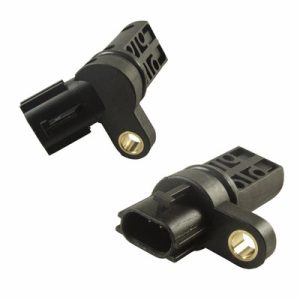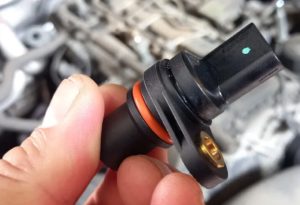In the world of modern automotive engineering, precision is everything — especially when it comes to engine timing. Every rotation, spark, and injection must occur at the exact right moment for your engine to perform efficiently and reliably. Two key components that make this possible are the camshaft position sensor and the crankshaft position sensor. These unsung heroes of the engine management system continuously monitor the position and speed of critical engine parts, providing the data necessary for precise fuel injection, ignition timing, and valve operation.
Without them, your engine wouldn’t even start — and if they fail, performance problems and costly damage can follow. In this article, we’ll explore how these sensors work, why they’re essential for timing, how to detect issues, and what to consider when replacing them.
What Are Camshaft and Crankshaft Position Sensors?

Both sensors serve as the “eyes” of the engine control unit (ECU), constantly reporting the position and rotational speed of the engine’s moving parts. While they work together, each has a distinct role:
-
Crankshaft Position Sensor (CKP): Monitors the position and rotational speed of the crankshaft — the main shaft that converts the pistons’ up-and-down motion into rotational motion.
-
Camshaft Position Sensor (CMP): Tracks the camshaft’s position, which controls the opening and closing of the intake and exhaust valves.
The ECU uses signals from both sensors to calculate the precise moment for spark plug ignition and fuel injection. This synchronization ensures maximum power, efficiency, and minimal emissions.
How These Sensors Work Together
| Sensor | Function | What It Controls | Key Role in Timing |
|---|---|---|---|
| Crankshaft Position Sensor (CKP) | Measures crankshaft rotation speed and position. | Ignition timing, fuel injection start. | Provides the reference point for engine cycle timing. |
| Camshaft Position Sensor (CMP) | Measures camshaft rotation and valve timing. | Synchronizes fuel injection and valve operation. | Ensures valves open/close in sync with piston position. |
Together, these sensors allow the ECU to determine the Top Dead Center (TDC) — the point when a piston is at its highest position in the cylinder. This is essential for precisely timing the spark and fuel delivery.
Why These Sensors Are So Critical
Accurate timing is the backbone of engine performance. Even slight errors in timing can cause power loss, reduced fuel efficiency, or catastrophic engine damage.
Key reasons why these sensors are vital:
-
Precise Ignition Timing: Ensures the spark plug fires exactly when needed.
-
Accurate Fuel Injection: Determines the correct injection moment for optimal combustion.
-
Proper Valve Timing: Synchronizes camshaft and crankshaft movement to prevent valve-piston collisions.
-
Efficient Engine Start: Without accurate position data, the ECU cannot start the engine.
-
Emission Control: Proper timing ensures complete combustion, reducing harmful emissions.
Signs of a Failing Camshaft or Crankshaft Sensor
Like all electronic components, these sensors can wear out or fail over time due to heat, vibration, or contamination. Early detection is crucial to avoid engine damage.
Here are common symptoms to watch out for:
Common Warning Signs:
-
Check Engine Light (CEL): A sensor malfunction is often detected and logged by the ECU.
-
Hard Starting or No Start: A failed crankshaft sensor can prevent the engine from starting.
-
Rough Idling or Misfiring: Incorrect timing leads to inefficient combustion.
-
Loss of Power and Poor Acceleration: Timing errors reduce performance.
-
Engine Stalling: Intermittent signal loss causes the engine to shut off unexpectedly.
How to Diagnose and Test These Sensors
If you suspect an issue, diagnosis should be done promptly. Here’s a quick guide:
Step-by-Step Diagnostic Process:
-
Check for Error Codes: Use an OBD-II scanner. Codes like P0335 (Crankshaft Sensor) or P0340 (Camshaft Sensor) indicate sensor issues.
-
Inspect Wiring and Connectors: Look for corrosion, loose connections, or damaged wires.
-
Perform a Resistance Test: Use a multimeter to check sensor resistance according to manufacturer specs.
-
Check Signal Output: A failing sensor may produce weak or no signal when the engine is cranking.
Replacement Tips and Best Practices
If your camshaft or crankshaft sensor is failing, replacement is often the most effective solution. Here’s how to do it safely and effectively:
Replacement Checklist:
-
Disconnect the battery before starting work.
-
Locate the sensor (usually near the crank pulley or camshaft gear).
-
Carefully unplug the connector and remove the mounting bolt.
-
Install the new sensor and reconnect everything.
-
Clear any diagnostic codes with an OBD-II scanner.
Pro Tip: Always use high-quality sensors to ensure reliability and accuracy. Cheap alternatives might work temporarily but often fail sooner and provide inaccurate data.
Maintenance and Prevention Tips
Regular maintenance can extend the life of these sensors and prevent unexpected breakdowns. Here’s how to keep them in good condition:
| Maintenance Task | Frequency | Benefit |
|---|---|---|
| Inspect wiring and connectors | Every 20,000–30,000 km | Prevents signal loss |
| Clean sensor area of oil and debris | During oil changes | Avoids contamination |
| Check error codes periodically | Every 10,000 km or before long trips | Early problem detection |
| Replace sensors proactively | ~100,000–150,000 km | Avoids sudden engine failure |
Where to Find Quality Replacement Sensors

Choosing the right sensors is essential for reliable engine performance and longevity. Poor-quality components may lead to inaccurate readings, frequent failures, and costly repairs.
For reliable, OEM-quality options, you can buy Camshaft Position Sensors and Crankshaft Sensors online and ensure your vehicle’s timing system stays precise and efficient.
Conclusion
Camshaft and crankshaft position sensors are more than just small electronic parts — they are vital for your engine’s timing, efficiency, and performance. Together, they synchronize combustion, optimize fuel use, and prevent catastrophic mechanical failures. Without them, your vehicle wouldn’t start, run smoothly, or deliver the performance you expect.
By understanding their function, recognizing signs of failure, and replacing them when necessary, you’ll protect your engine and ensure it continues to operate at peak efficiency for years to come. Regular inspections and timely maintenance can save you from expensive repairs and keep your vehicle running like new.
In short, never underestimate the importance of these two critical sensors — they’re the silent partners behind every powerful, efficient, and reliable engine.